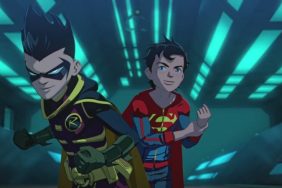From Austin’s Fantastic Fest 2009

Michael Spierig has a shocking confession to make.
“When we made Daybreakers, I had never even heard of Twilight,” says Michael, who directed the upcoming vampire saga with brother Peter. “Our lead character’s name is Edward, and I started seeing these Edward the Vampire T-shirts. I’m like, âDo they already know about our film? What the hell’s going on?’ And I’m told there’s this other thing called Twilight. And I go, “What the hell’s Twilight?'”
The Spierigs – the Australia brothers who first caught our attention with 2003’s micro-budgeted zombie saga Undead – now know all too well about the girl-friendly Twilight saga. But they’re not worried the sequel New Moon will take a bite out of the ultra-violent Daybreakers‘s business when it opens Jan. 10, 2010.
“I think it’s actually going to help us,” Michael says. “I would be worried if our film was like those, but our film is so different.”
And how so. The vampires played by Daybreakers‘s Ethan Hawke and Twilight‘s Robert Pattinson may share the same first name, but that’s where the similarities end. In Daybreakers, the fanged fiends desire human blood, not love. A decade after a plague turned billions into vampires, though, there’s not much blood left. The human race is close to extinction, and those suffering from blood deprivation are mutating into frenzied bat-like creatures called Subsiders. As a hematologist, Hawke’s ordered by his boss Sam Neill to quickly create a synthetic blood substitute. But when Willem Dafoe offers himself as living proof that vampires can revert back to human, Hawke pursues a course of action that he hopes will put an end to his and all others’ bloodsucking ways for good.
A day after Daybreakers received its U.S. premiere at Fantastic Fest ’09, the Spierigs sat down to speak with ShockTillYouDrop and other media members to discuss creating a world controlled by vampires, enticing Ethan Hawke to bear his fangs, and the process of directing a film together.
Question: First zombies, now vampires? What next – werewolves?
Michael Spierig: If there actually is a good werewolf script out there, I’d love to do it. It’s been while there’s been a good werewolf; there hasn’t been a good one since Dog Soldiers. We just look for good scripts, and we didn’t intend on doing a vampire pic after Undead. We just came up with an idea and rolled with it. Six years later out comes Daybreakers. The project we’re working on at the moment is a science-fiction film [adaptation of the swashbuckler] Captain Blood. It’s very different to Undead or Daybreakers.
Question: Would you ever considering not directing a film together?
Peter Spierig: If Michael’s really passionate about something, and I’m really passionate about something, and it’s happening at the same time, quite possibly.
Michael: When we did Daybreakers, it felt like we did that a little bit. The schedule was pretty tight, so we split up often into two units, directing different actors at different times, which producers like because it’s double the production value. You never have to hand it off to another second unit director who doesn’t know the script or the ideas as intimately as the writer-directors would.
Question: What’s the division of labor?
Peter: It’s 50-50 much pretty the whole way.
Michael: We really pre-visualize everything in the sense we storyboard the movie and we did all the animatics ourselvesâ¦. So there’s not a lot of confusion when we get on set; we’re not steering in two different directions. It’s pretty seamless as far as having a singular vision.

Question: There’s social commentary running throughout Daybreakers. Is that something you added or it is a manifest result of creating such a community and environment?
Peter: It was always intended to be there, the idea of exploiting resources to the point that it has a detrimental effect on your world. It’s pretty obvious; it’s there in the film. The one thing we did talk a lot about was not to do it in a sort of way that would be too heavy-handed. Ultimately we’re making a piece of entertainment. It’s got to be fun. If you put in some social commentary that’s taking over from the enjoyment of the movie, then it becomes a problem. We talked a lot about how well [George A.] Romero does it just trying to find that balance.
Question: Daybreakers‘s cast includes Ethan Hawke, Willem Dafoe and Sam Neill. How did you sell them on joining the project?
Michael: Ethan was the first one to jump onboardâ¦. Initially he said when his agent told him he had this script, a vampire film, he was like, “Vampires? I don’t know. I really don’t want to do it.” He sat down and read it and he fell in love with it. Because he said yes, it legitimized the project, and then we could get Sam Neill and Willem Dafoe. To his credit, [Hawke] was really instrumental to elevating the film to another level.
Question: Why adopt a retrofuturistic for the vampires dress and the world they live in?
Peter: We wanted to create a timeless feelâ¦. We didn’t want the tinfoil future look. One of the best ways to do it is to go back to a classic look, and I think one of the best periods of design and fashion was probably around the ’40s going into the ’50s.
Question: Based on your experiences making Undead and Daybreakers, you did find you had more creative freedom directing a small independent vs. a studio film with a larger budget and a bigger-name cast?
Michael: Not really. Undead had so many limitations because we had no money. That film was difficult to make. There was no one working on Undead who had made a feature film before, including cast, including crew. When you get onto a larger film, you get a sense of joy or a sense of confident in working with more experienced people. I think the best thing a director can do is work with people who are so much better than they are. And when you get great actors that offer so much more, and when you get a great cinematography and designer and effects people, they just offer so much more. There’s something great about getting to work with people at that level. As far as having to sanitize a film, because you’re obligated to make more money back, we didn’t have that problem, either. Lionsgate are pretty open to going all out. These are the guys that make the Saw movies.
Peter: They never really stepped in a said, “Guys, this is your first big movie and we’re going to micromanage it and watch over you the whole time.” And the other thing we made sure of with our second movie is that we shot it in Australia. So we were far, far away from Hollywood.
Question: And you could always cite Saw if anyone thought the violence was too extreme, right?
Michael: That was never an issue. It was more like, “Guys, is this bloody enough?”
Question: You shot Daybreakers in 2007. It doesn’t open until January 2010. Why the delay?
Michael: There are several factors. There’s a fairly long post process, running out of money, finding more money and all that sort of stuffâ¦. We were supposed to be released around this time, right now. I’m glad we didn’t actually, because it seems like there are so many horror films and they’re all just dying because there’s so much saturation.
Peter: And what also happened was that we had a test screening and it tested really well. It was one of the highest-tested Lionsgate horror films. So they realized they were going to put it on a date that gave it a real chance of opening and opening probably. And the only date that was available was in January.
Michael: It’s definitely a different time now. When we made Undead, that screened very briefly in cinemas across America, and there’s no way we could ever get a movie like that into cinemas nowadays with the amount of movies that are out there.

Question: It is a help or a hindrance that there are so many vampire films out there today?
Peter: We had no idea the first Twilight film had been announced by the time we were making [Daybreakers]. It’s just one of things that happened. The vampire ⦠is really the first movie monster that ever existed in cinema. [The genre’s] been around forever, and it will be around for as long as we’re around, as long as human beings are around.
Question: R-rated horror films have having a tough time at the box office when they are a remake, a sequel to a hit like Saw, or in 3-D. Any concerns for Daybreakers?
Peter: I think it definitely helps that we’re in a genre that’s really popular. And the other thing that we have, which perhaps some of those other R-rated horror films don’t have, is that we have a really recognizable cast. That is definitely going to help us as well.
Question: Daybreakers features vampires that do not cast reflections in the mirror and burn when exposed to the sunlight. In this day and age of Twilight, why populate Daybreakers with such old-school vampires?
Peter: We wanted to do the popular-culture vampire myth and then also try to add something new to it. When you twist it too much, when you take one element and you add in a whole bunch of other stuff that’s outside what the popular culture accepts, I find it a little bit disrespectful to the genre. I’d rather take the rules and then subvert them in a way and do something different. I don’t get the sparkling skin [in Twilight]. I really don’t understand that one.
Question: Why it is necessary to respect the vampire myth?
Peter: What I love about it is the fascination with immortality and there are very few monsters out there that are kind of attractive and have a sexual appeal. People are drawn to that kind of stuff. The idea of blood being life, it all is very connected to us in a very subconscious level.
Question: Daybreakers ends withâ¦
Michael and Peter (together): Shh!
Question: Have you already decided what happens next?
Michael: Absolutely, we have. We don’t want to jinx anything. We’ll see what happens in January, but we do have a lot of ideas if we get to do another one. [There will be] a lot more Subsiders if we get to do another one.
For our exclusive interview with the brothers at the Toronto International Film Festival click here (it covers some different ground).
Source: Robert Sims










